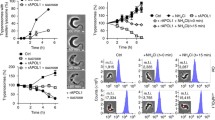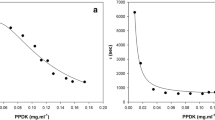Abstract
The kinetic properties of ATP hydrolysis and synthesis by FoF1-ATPase of heart mitochondria were evaluated during the acute phase of T. cruzi infection in rats. Mitochondria and submitochondrial particles were isolated 7 days (early stage) and 25 days (late stage) following infection of rats with 2 × 105 trypomastigote forms of the Y strain of T. cruzi. The kinetic properties for ATP hydrolysis were altered for the early but not the late stage, showing a changed pH profile, increased K0.5 values, and a decreased total Vmax. The Arrhenius' plot for membrane-associated enzyme showed a higher transition temperature with a lower value for the activation energy in body temperature. For the Triton X-100 - solubilized enzyme, the plot was similar to the control. A decrease in the efficiency of ADP phosphorylation by mitochondria, measured by the firefly-luciferase luminescence, was observed only during the late stage and appeared to be correlated with a decrease in the affinity of the FoF1-ATPase for ADP. It is proposed that in the early stage, during the acute phase of T. cruzi infection in rats, heart FoF1-ATPase undergoes a membrane-dependent conformational change in order to maintain the phosphorylation potential of mitochondria, which would compensate for the uncoupling of mitochondrial function. Also, during both the early and late stages, the enzyme seems to be under the regulation of the endogenous inhibitor protein for the preservation of cellular ATP levels.
Similar content being viewed by others
References
Koberle F: Chagas' disease and Chagas' syndromes: The pathology of American Trypanosomiasis. Adv Parasitol 6: 63–116, 1968
Oliveira JSM: A natural human model for intrinsic heart nervous system denervation: Chagas' cardiopathy. Am Heart J 110: 1092–1098, 1985
Rossi MA: Microvascular changes as a cause of chronic cardiomyopathy in Chagas' disease. Am Heart J 20: 233–236, 1990
Junqueira Jr. LF, Berardo PSS, Chapadeiro E, Jesus PC: Cardiac autonomic dysfunction and neuroganglionitis in a rat model of chronic Chagas' disease. Cardiovasc Res 26: 324–329, 1992
Mengel JO, Rossi MA: Chronic chagasic myocarditis pathogenesis-Dependence on autoimmune and microvascular factor. Am Heart J 124: 1052–1058, 1992
Jennings RB, Hawkins HK, Lowe JE, Hill ML, Klotman S, Reimer KA: Relation between high energy phosphate and lethal injury in miocardial ischemia in the dog. Am J Pathol 92: 187–214, 1978
Rouslin W: Protonic inhibition of the mitochondrial oligomycin-sensitive adenosine 5′-triphosphatase in ischemic and autolyzing cardiac muscle. J Biol Chem 258: 9657–9661, 1983
Rouslin W, Broge CW: Mechanism of ATP conservation during ischemia in slow and fast heart rate hearts. Am J Physiol 264: C209-C217, 1993
Boyer PD, Chance B, Ernster L, Mitchell P, Racker E, Slater EC: Oxidative phosphorylation and photophosphorylation. Ann Rev Biochem 46: 955–1026, 1977
Hatefi Y: The mitochondrial electron transport and oxidative phosphorylation system. Ann Rev Biochem 54: 1015–1069, 1985
Pedersen PL, Amzel LM: ATP Synthases: structure, reaction center, mechanism, and regulation of one of natures most unique machines. J Biol Chem 268: 9937–9940, 1993
Harris DA, Das AM: Control of mitochondrial ATP synthesis in heart. Biochem J 280: 561–573, 1991
Uyemura SA, Albuquerque S, Curti C: Energetics of heart mitochondria during acute phase of Trypanosoma cruzi infection in rats. Int J Biochem & Cell Biol, 27: 1183–1189, 1995
Uyemura SA, Curti C: Steady-state kinetic properties of FoF1-ATPase: the pH effect. Int J Biochem 24: 1743–1748, 1992
Murphy JB, Kies MW: Note on spectrophotometric determination of protein in dilute solutions. Biochim Biophys Acta 45: 382–384, 1960
Souza MEJ, Polizello ACM, Uyemura SA, Castro-Silva Jr. O, Curti C: Effect of fluoxetine on rat liver mitochondria. Biochem Pharmacol 48: 535–541, 1994
Lemasters JJ, Hackenbrock CR: Continuous measurement and rapid kinetics of ATP synthesis in rat liver mitochondria, mitoplasts and inner membrane vesicles determined by firefly-luciferase luminescence. Eur J Biochem 67: 1–10, 1976
Slater EC, Rosing J, Mol A: The phosphorylation potential generated by respiring mitochondria. Biochim Biophys Acta 292: 534–553, 1973
Van de Stadt RJ, De Boer BL, Van Dam K: The interaction between the mitochondrial ATPase (F1) and the ATPase inhibitor. Biochim Biophys Acta 292: 228–349, 1973
Cintron N M, Hullihen J, Schwerzmann K, Pedersen P L: Proton-adenosine triphosphatase complex of rat liver mitochondria: Effect of its inhibitory peptide on adenosine 5′-triphosphatase hydrolytic and functional activities of the enzyme. Biochemistry 21: 1878–1885, 1982
De Miguel C, Encio I, Lópes-Moratalla N, Santiago E: Interaction of F1-ATPase and its inhibitor peptide: Effect of pH. Int J Biochem 20: 977–981, 1988
Pullman ME, Monroy GC: A naturally occurring inhibitor of mitochondrial adenosine triphosphatase. J Biol Chem 238: 3762–3769, 1963
Rouslin W, Pullman ME: Protonic inhibition of the mitochondrial adenosine 5′-triphosphatase in ischemic cardiac muscle. Reversible binding of the ATPase inhibitor protein to the mitochondria ATPase during ischemia. J Mol Cell Cardiol 19: 661–668
Lippe G, Sorgato MC, Harris DA: Kinetics of release of the mitochondrial inhibitor protein-Correlation with synthesis and hydrolysis of ATP. Biochim Biophys Acta 933: 1–11, 1988
Tuena de Gómez-Puyou M, Martins OB, Gómez-Puyou A: Synthesis and hydrolysis of ATP by mitochondrial ATP synthase. Biochem Cell Biol 66: 677–682, 1988
Dorgan LJ, Urbauer JL, Schuster SM: Metal dependence and thermodynamic characteristics of the beef heart mitocondrial adenosine triphosphatase. J Biol Chem 259: 2816–2821, 1984
Baracca A, Curatola G, Parenti Castelli G, Solaine G: The kinetic and structural changes of the mitochondrial F1-ATPase with temperature. Biochem Biophys Res Comm 136: 891–898, 1986
Matsuno-Yagi A, Hatefi Y: Studies on the mechanism of the oxidative phosphorylation-Positive cooperativity in ATP synthesis. J Biol Chem 265: 82–88, 1990
Author information
Authors and Affiliations
Rights and permissions
About this article
Cite this article
Uyemura, S.A., Jordani, M.C., Polizello, A.C.M. et al. Heart FoF1-ATPase changes during the acute phase of Trypanosoma cruzi infection in rats. Mol Cell Biochem 165, 127–133 (1996). https://doi.org/10.1007/BF00229474
Received:
Accepted:
Issue Date:
DOI: https://doi.org/10.1007/BF00229474




